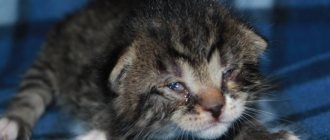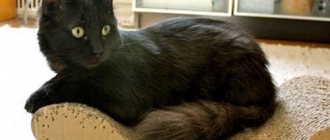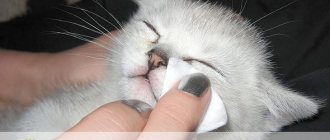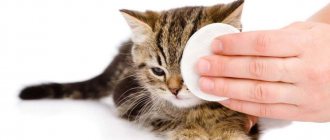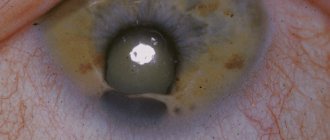Suppuration: normal or pathological?
Eye discharge does not always appear due to pathological processes developing in the body.
In some cases, pus in a cat accumulates under the eyelids for the following reasons:
- weakened immune system;
- improperly selected diet (lack of nutrients);
- infectious, viral damage;
- unsanitary conditions when keeping animals;
- draft;
- eye injuries;
- allergic reaction to household chemicals, perfumes;
- inflammatory processes in the cornea (keratitis);
- dust in the room where the pet is kept.
On a note! If the discharge is abundant and prolonged, you should not resort to self-medication; the animal must be taken for examination to a veterinary clinic, where the doctor will determine the cause and prescribe adequate treatment.
The owner should pay attention to the color of the discharge. Rare discharge of a grayish tint is normal, and thick discharge of a yellowish or green tint most likely indicates the development of pathological processes in the body.
Symptoms and associated disorders
Associated symptoms may indicate a specific disease. If your animal's eyes are watery and additional painful signs appear, then this is a reason to immediately contact a veterinarian.
Nature of the discharge
The first step is to determine the nature of the discharge - if it is thick, has a yellow or greenish tint, then most likely the kitten has an infectious disease or fungus. Purulent exudate can also appear due to neglected injury.
Transparent and watery discharge most often indicates an allergic reaction or the entry of a speck.
If the kitten’s eyelids do not stick together and discharge does not appear during the day, but only after waking up, then everything is normal.
Tumor of the eyelids
Swollen eyelids are a symptom that needs to be addressed promptly. If a kitten's eyes become very purulent, and the eyelids become swollen and red, it could be blepharitis, an eyelid injury, or an allergy. The tumor causes severe discomfort to the small pet, so treatment should be started as soon as possible.
Emergence of the third century
Normally, the third eyelid is hidden and can only peek out when the animal is sleeping. If it is visible constantly, then this is an alarming signal. The first thing to suspect is infections, viruses or allergies. Perhaps the reason lies in parasites (fleas, worms) or internal diseases (for example, chronic kidney failure or gastrointestinal problems).
There is a possibility of adenoma of the third eyelid - a benign formation that appears directly on the film. There is no point in diagnosing it yourself - it is better to take the little patient to the veterinarian.
Runny nose
If a kitten's eyes are festering and a runny nose appears, then it is unlikely that it is a cold, which cats practically do not get sick with. The combination of discharge from the eyes and nose can be a sign of feline distemper, herpes, chlamydia, calcivirus infection, etc. - the list of possible causes is very extensive. All of them are deadly without proper treatment.
If a kitten develops a fever, shortness of breath, thirst, or diarrhea (especially with blood), then this is a clear sign of damage to the animal’s immune system.
General condition and behavior
It is easier to notice an illness in a kitten than in an adult cat, at least because the usually playful baby becomes lethargic and inactive. Often his appetite decreases or completely disappears, and his temperature rises.
If the eye hurts, the kitten will hide from bright light, trying to spend more time alone. Severe itching is difficult to miss - the baby will always scratch the eyelid with his back paw or rub with his front paw.
If a kitten is in severe pain, it may follow its owner and meow loudly, rub against its legs, attracting attention to itself.
Serious diseases, in addition to all of the above, are usually accompanied by upset stool and digestion in general, nasal discharge, salivation, and the appearance of wounds on the oral mucosa.
Suppuration: 5 main reasons
The main reasons for the appearance of pus:
- Thick, yellow pus is a sign of an infectious, viral, or fungal disease. The cause of this symptomatology is bacteria or viruses that have entered the animal’s body. Associated symptoms: increased body temperature, apathy, refusal to eat, matted fur around the eyes.
- Cold. If a kitten has a cold, purulent discharge can serve as one of the symptoms of a cold, additional symptoms: sneezing, mucus discharge from the nasal passages, lethargy, chills.
- Ophthalmological diseases. Pathologies of the eyelids, inflammation of the cornea, conjunctiva, blepharitis can become the reason due to which suppuration begins on the organs of vision.
- Allergic reaction. Pus can be released if the animal is allergic to food, household chemicals, perfumes, or pollen.
- In case of mechanical damage to the eye, the wound may become infected, in these cases pus will begin to ooze from the organ of vision.
Be sure to read:
Kitten constantly sleeps: physiological and pathological reasons, what affects when to sound the alarm
The kitten is a month old, its eyes are festering: reasons
With blepharitis, the eyelids become inflamed. This occurs due to exposure to an allergen, burn, or contact with harmful chemicals. Blepharitis occurs when a kitten is infected with worms, or with seborrhea. Often occurs due to vitamin deficiency.
Kitten is one month old, eyes are festering, reasons:
- Lesion in the eyelid area . This happens if the baby has a conflict with his brothers and sisters, or other animals with whom he lives. Perhaps you didn’t notice when the cats got into a fight and one scratched the other’s eye.
- Foreign object in the eyelid area . Just like in humans, when particles or food particles come into contact, the eyelids become swollen and the eyes turn sour. It is necessary to remove the foreign object from the eye.
- Violation of temperature standards in the room . In a draft, the kitten may catch a cold.
- Viral diseases. This often happens to homeless and domestic cats. A doctor will help you deal with such ailments.
Conjunctivitis
What can you do before visiting a doctor?
If there is heavy discharge, do not put off going to the veterinarian. Before going to the veterinary clinic, you can relieve your pet's condition by rinsing the eyes yourself.
Until the causes of the disease are determined and adequate therapy is prescribed, the following should be used:
- weak solution of potassium permanganate,
- herbal infusion,
- decoction of tea leaves.
Any of the above products must be cooled to room temperature.
How to carry out the procedure:
- Calm the animal, secure the paws with a towel, wrap the entire body, and lay it on its side.
- Use a pipette or syringe without a needle to drip warm boiled water onto your eyes to soften dried discharge, and gently wipe your eyelids with a swab.
- Moisten 2 cosmetic discs generously in the solution, wipe each eye with a separate disc.
On a note! To avoid infection in a healthy organ of vision, you should take a new cotton pad after each wiping; repeated use is unacceptable.
During treatment, do not bring the syringe or pipette close to the eyes; the kitten may twitch, which will lead to mechanical injury. Processing is carried out from the outer corner towards the inner.
How to wash a kitten's eyes?
It is necessary to wash the eyes of a sick kitten as often as possible. The faster and more thoroughly you eliminate the source of infection, the faster the recovery will come.
To soak and remove crusts you can use:
- Clean boiled water.
- Strong brew of tea (real, loose leaf).
- Warm saline solution diluted with clean water (1:1).
- Decoctions of antiseptic herbs can cause an allergic reaction.
- Veterinary solutions for cleaning eyelids.
A cotton sponge is thoroughly moistened with the selected solution, which must be applied to the kitten’s eye and held for a while. After a few minutes, the discharge is cleared and can be easily eliminated. Discharge should be removed by moving from the nose to the ear.
Important! Don't skimp on cotton sponges! Rubbing with the same sponge several times will only make the situation worse.
Prevention of re-infection
The best treatment is prevention! To prevent a kitten from getting conjunctivitis, it is important to protect it from sources of viruses and infections: household waste and stray animals. In many purebred animals, discharge from the eyes may be a consequence of eating foods containing sugar or smoked meats.
As a preventive measure, cats with upturned or sunken noses are advised to clean their eyelids once a day or as needed. During periods of strong winds and grass flowering, try not to take your pet for a walk. Additional irritants can provoke discharge from the eyes, against the background of an allergic reaction.
Suppuration with a runny nose, what to do
Eye discharge accompanied by chills, sneezing, and snot most often indicate a runny nose. For a fragile body, a runny nose can serve as an impetus for the development of serious diseases, such as viral rhinotracheitis or calcivirosis.
If you suspect the development of the disease, you should take the animal to a veterinary clinic, where a doctor will examine it, prescribe tests and a treatment regimen.
Medicines that are most often prescribed for colds to treat suppuration:
- anti-inflammatory drugs,
- antibiotics,
- immunomodulators.
Diagnostics in a veterinary clinic
The examination at the clinic will be carried out in several stages.
First, the doctor will ask the owners about known symptoms, the nature of the discharge, the frequency and timing of its appearance. In addition, pet owners can provide information about chronic or recent diseases, which will help reduce the list of causes of possible illness.
Secondly, the veterinarian will examine the kitten himself. He will notice additional symptoms, if any, that the owner may not have paid attention to. Sometimes a survey and examination are enough to make an accurate diagnosis.
What drops and ointments to use
For ocular discharge, veterinarians advise using various ointments and drops for treatment. In order for the drug to be beneficial, the owner must follow a number of rules.
How to instill drops:
- Pre-rinse the eye mucosa with herbal decoction or tea leaves.
- Secure the pet and lay it on its side.
- Pipette drops at room temperature.
- Gently drip into outer corners.
- Remove residues with a dry cotton pad.
Be sure to read:
The cat has a stuffy nose: reasons, how to treat it, is it possible to use nasal drops, what will happen if the runny nose is not treated
How to apply the ointment:
- Warm the prescribed drug in your palms to room temperature.
- Secure the pet with a towel and lay it on its side.
- With clean hands, place the ointment under the lower eyelids, pulling them slightly.
- Massage the eyelids with the ointment for a few seconds.
- Rub the treated eyes with a dry cotton swab to remove excess.
Commonly prescribed ointments:
- tetracycline eye ointment,
- hydrocortisone,
- solcoseryl.
Popular drops:
- albucid,
- gentamicin drops,
- veterinary drops “Iris”, “Bars”, “Diamond Eyes”,
- levomecithin drops.
How to treat at home
At home, you can try to get rid of pus by regularly treating the mucous membranes of the eyes with a solution of furatsilin, a decoction of medicinal herbs.
It is not advisable to use eye drops purchased at a pharmacy without a prescription from a veterinarian. A dosage suitable for humans can lead to serious consequences if used on a kitten.
You can put tetracycline eye ointment under the patient's lower eyelids.
If the kitten’s condition does not improve 2-3 days after the start of treatment, a visit to the veterinary clinic should be made.
Folk remedies
At home, for rinsing, it is recommended to use infusions, solutions, and decoctions prepared on the basis of medicinal herbs.
- Rinse with saline solution.
Add half a teaspoon of table salt to 500 ml of chilled boiled water and stir thoroughly. Rinse eyes 2-3 times a day with cotton pads. Do not use if the condition is caused by an allergen entering the body.
- Treatment with herbal infusion.
Prepare a mixture of dried herbs (calendula, sage) at a ratio of one to one. Pour a couple of tablespoons of the mixture into 500 ml of cold water, place in a steam bath, cook for 12-15 minutes, strain, cool. Carry out treatment several times a day.
- Washing with tea.
Pour a glass of boiling water over a bag of green tea and let it brew. Rinse the organs of vision in case of mechanical injuries, inflammatory processes to relieve inflammation.
- Treatment with solutions of furatsilin, boric acid.
Be sure to read:
What should you do if your cat develops a lump at or near the injection site after vaccination? When does a tumor become oncology?
Prepare a solution at the rate of: 2 drops of furatsilin per tablespoon of boiled water or a pinch of boric acid per glass of boiled water. Treat 2 times a day.
The kitten's eye is closed and is festering - what should I use?
Drops can be used to treat eye suppuration in cats. It is worth noting that they are less effective than ointments due to their liquid state. With frequent blinking, they are washed out of the eyes along with tears and secretions. Below is a list of eye drops for suppuration in cats.
The kitten's eye has closed and is festering, what to apply:
- Lachrikan
- Lacrimin
- Tsiprovet
- Barrier
- Dexamethasone
It is necessary to treat suppuration of a cat’s eyes with drops for 2 weeks. Please note that they must be used according to the instructions, most often applied 3-5 times a day, 2 drops in each eye. You will also need the help of someone close to you to stabilize the cat's head and inject the medicine into the eye area.
The situation is more complicated if the cat has blepharitis or keratitis. These diseases must be treated under the supervision of a doctor with regular visits to the clinic. The fact is that infectious blepharitis, as well as keratitis, are often treated with antibiotics, not only local ones, but also those that are administered orally.
Most often these are injections, that is, injections. You may have to take your cat to the veterinary clinic for injections every day. If conservative treatment is ineffective, surgery is often prescribed to remove keratotic nodes, as well as suppuration in the eyelid area, for blepharitis.
Eyes fester
Medications
- Hydrocortisone drops with novocaine - to relieve swelling, inflammation, pain.
- Gentamicin drops - for severe inflammatory processes.
- Albucid drops - for the treatment of injuries.
- Drops with chloramphenicol - for infectious lesions.
- Drops with atropine - for the development of photophobia.
- Solcoseryl ointment - for healing mucous membranes in case of injuries.
- Tetracycline ointment for allergic reactions, to relieve inflammation.

